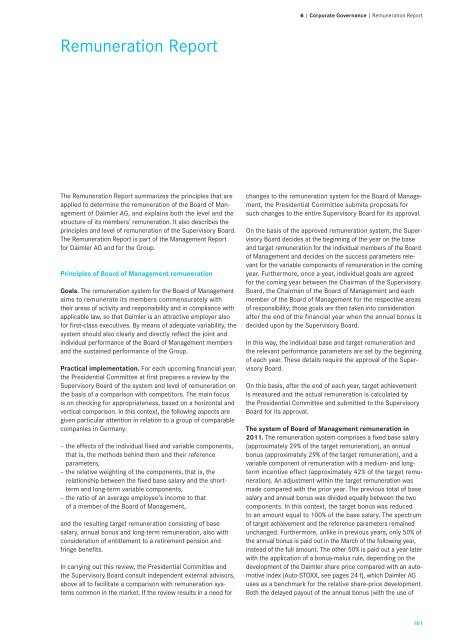Daimler Annual Report 2011 - Alle jaarverslagen
Daimler Annual Report 2011 - Alle jaarverslagen
Daimler Annual Report 2011 - Alle jaarverslagen
Create successful ePaper yourself
Turn your PDF publications into a flip-book with our unique Google optimized e-Paper software.
6 | Corporate Governance | Remuneration <strong>Report</strong><br />
Remuneration <strong>Report</strong><br />
The Remuneration <strong>Report</strong> summarizes the principles that are<br />
applied to determine the remuneration of the Board of Management<br />
of <strong>Daimler</strong> AG, and explains both the level and the<br />
structure of its members’ remuneration. It also describes the<br />
principles and level of remuneration of the Supervisory Board.<br />
The Remuneration <strong>Report</strong> is part of the Management <strong>Report</strong><br />
for <strong>Daimler</strong> AG and for the Group.<br />
Principles of Board of Management remuneration<br />
Goals. The remuneration system for the Board of Management<br />
aims to remunerate its members commensurately with<br />
their areas of activity and responsibility and in compliance with<br />
applicable law, so that <strong>Daimler</strong> is an attractive employer also<br />
for first-class executives. By means of adequate variability, the<br />
system should also clearly and directly reflect the joint and<br />
individual performance of the Board of Management members<br />
and the sustained performance of the Group.<br />
Practical implementation. For each upcoming financial year,<br />
the Presidential Committee at first prepares a review by the<br />
Supervisory Board of the system and level of remuneration on<br />
the basis of a comparison with competitors. The main focus<br />
is on checking for appropriateness, based on a horizontal and<br />
vertical comparison. In this context, the following aspects are<br />
given particular attention in relation to a group of comparable<br />
companies in Germany:<br />
– the effects of the individual fixed and variable components,<br />
that is, the methods behind them and their reference<br />
parameters,<br />
– the relative weighting of the components, that is, the<br />
relationship between the fixed base salary and the shortterm<br />
and long-term variable components,<br />
– the ratio of an average employee’s income to that<br />
of a member of the Board of Management,<br />
and the resulting target remuneration consisting of base<br />
salary, annual bonus and long-term remuneration, also with<br />
consideration of entitlement to a retirement pension and<br />
fringe benefits.<br />
In carrying out this review, the Presidential Committee and<br />
the Supervisory Board consult independent external advisors,<br />
above all to facilitate a comparison with remuneration sys -<br />
tems common in the market. If the review results in a need for<br />
changes to the remuneration system for the Board of Management,<br />
the Presidential Committee submits proposals for<br />
such changes to the entire Supervisory Board for its approval.<br />
On the basis of the approved remuneration system, the Supervisory<br />
Board decides at the beginning of the year on the base<br />
and target remuneration for the individual members of the Board<br />
of Management and decides on the success parameters relevant<br />
for the variable components of remuneration in the coming<br />
year. Furthermore, once a year, individual goals are agreed<br />
for the coming year between the Chairman of the Supervisory<br />
Board, the Chairman of the Board of Management and each<br />
member of the Board of Management for the respective areas<br />
of responsibility; those goals are then taken into consideration<br />
after the end of the financial year when the annual bonus is<br />
decided upon by the Supervisory Board.<br />
In this way, the individual base and target remuneration and<br />
the relevant performance parameters are set by the beginning<br />
of each year. These details require the approval of the Supervisory<br />
Board.<br />
On this basis, after the end of each year, target achievement<br />
is measured and the actual remuneration is calculated by<br />
the Presidential Committee and submitted to the Supervisory<br />
Board for its approval.<br />
The system of Board of Management remuneration in<br />
<strong>2011</strong>. The remuneration system comprises a fixed base salary<br />
(approximately 29% of the target remuneration), an annual<br />
bonus (approximately 29% of the target remuneration), and a<br />
variable component of remuneration with a medium- and longterm<br />
incentive effect (approximately 42% of the target remuneration).<br />
An adjustment within the target remuneration was<br />
made compared with the prior year. The previous total of base<br />
salary and annual bonus was divided equally between the two<br />
components. In this context, the target bonus was reduced<br />
to an amount equal to 100% of the base salary. The spectrum<br />
of target achievement and the reference parameters remained<br />
unchanged. Furthermore, unlike in previous years, only 50% of<br />
the annual bonus is paid out in the March of the following year,<br />
instead of the full amount. The other 50% is paid out a year later<br />
with the application of a bonus-malus rule, depending on the<br />
development of the <strong>Daimler</strong> share price compared with an automotive<br />
index (Auto-STOXX, see pages 24 f), which <strong>Daimler</strong> AG<br />
uses as a benchmark for the relative share-price development.<br />
Both the delayed payout of the annual bonus (with the use of<br />
161

















